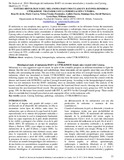Estudio histológico del melanoma B16F1 inoculado en ratones hembras c57bl/6//biou tratados con la formulación cytoreg

View/
Date
2015-11-10Author
Palabras Clave
Neoplasia, Cytoreg, Histopatología, Melanoma, Ratón C57BL/6//BIOULACancer, Histology, Pathology, C57BL/6//BIOULA mice
Metadata
Show full item recordAbstract
El melanoma es una neoplasia muy agresiva. A pesar del avance científico en las diferentes formas de tratamiento, para combatir dicha enfermedad como es el uso de quimioterapias y radioterapia, éstas son poco específicas, ya que pueden afectar a las células sanas circundantes al melanoma. En este trabajo se estudió el efecto de la formulación Cytoreg sobre el melanoma B16F1, inoculado en ratones hembras C57BL/6//BIOU. El estudio se realizó través del análisis histopatológico de los siguientes órganos: pulmón, hígado, bazo, corazón y piel del área del tumor, se realizó histología además de los grupos control (enfermo y tratado con INTRONA). Macroscópicamente no se observó la presencia de nódulos metastáticos. El análisis histopatológico de los tumores, reveló la presencia de tejido vivo, ubicado cerca de los vasos sanguíneos funcionales, observándose también, tejido necrótico ubicado cerca de vasos sanguíneo no funcionales. El porcentaje de tejido necrótico en los tumores presentes en cada uno de los grupos fue: de 40% para el enfermo control, de 10% para el de los animales tratados con INT A, y para el grupo de tratamiento con Cytoreg de 95%, conllevando a concluir que la formulación Cytoreg tuvo un efecto antiangiogénico sobre las células del melanoma.
Collections
Información Adicional
| Otros Títulos | Histological study of melanoma B16F1 in C57BL/6//BIOU female mice treated with Cytoreg |
| Correo Electrónico | rosadej@ula.ve cytorexinc@yahoo.com |
| ISSN | 0798-3166 |
| ISSN Electrónico | 2244-8829 |
| Resumen en otro Idioma | Melanoma is a very aggressive type of cancer. In spite of the scientific progress on different treatments to fight the disease, like the use of chemotherapy and radiotherapy, these treatments are not specific since they can affect the healthy cells surrounding the tumor. The aim of this work was to study the effect of Cytoreg® formula on the B16F1 melanoma, which was inoculated in female C57BL/6//BIOU mice, and then a histopathological analysis of the following organs was done: lung, liver, spleen, heart and skin from the tumor area, taken from the control (with the disease and treated with INTRONA) and the Cytoreg®-treated group. According to the histopathological analysis, there was not metastasis from the B16F1 melanoma, since no metastatic nodules were found. The analysis of the tumors confirmed the presence of live tissue located near the functional blood vessels, showing also necrotic tissue located near the non-functional blood vessels. The percentage of necrotic tissue in every group was: 40% for the EC group, 10% for the tumor from animals treated with INT A, and 95% for the Cytoreg® treated group. These results allow to conclude that Cytoreg® provoked an anti-angiogenic effect on the melanoma cells. |
| Colación | 76-83 |
| Publicación Electrónica | Revista MedULA |
| Sección | Revista MedULA: Artículos Originales |





